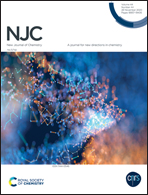Solvent-induced single-molecule magnet behavior and near-infrared luminescence properties of rare earth complexes†
Abstract
We synthesized two series of dinuclear rare earth complexes [RE2L2(acac)2(H2O)2]·i-PrOH (RE = Y (1), Eu (2), Dy (3), Ho (4), Er (5) and Yb (6)) and Dy2(L2)2(acac)2(C2H5OH)2 (7) (H2L = pyridine-2-carboxylic acid [(2-hydroxy-3-methoxyphenyl)methylene]hydrazide, Hacac = acetylacetone). The static (dc) magnetic susceptibility shows that the weak ferromagnetic interaction exists in DyIII of 3 and 7. Furthermore, the study of magnetization dynamics manifests that 7 possesses an energy barrier of about 45 K at a zero dc field, while the energy barrier of 3 is 42.93 K under the applied 800 Oe dc field by using a solvent-controlled crystallization. Interestingly, the energy barrier of 7 could attain 80.39 K through deteriorating the QTM. Besides, near-infrared luminescence analysis shows that the ligands can work as effective sensitizing agents of 5 and 6. We observed the characteristic peaks of ErIII and YbIII ions, meanwhile, complex 5 has a potential application for optical systems because the maximum peak is located in the third telecommunication window about 1531 nm.



 Please wait while we load your content...
Please wait while we load your content...